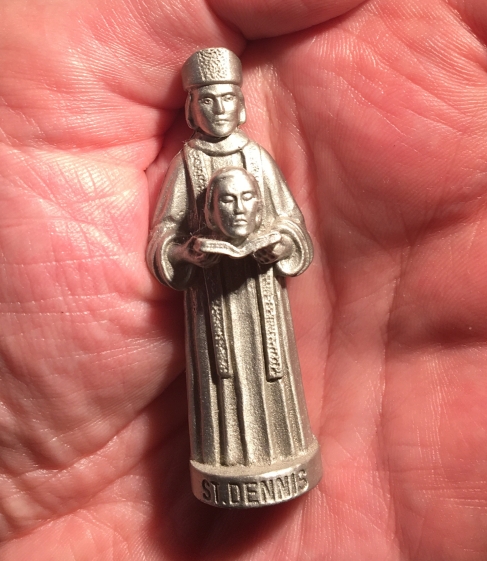St. Denis was the Bishop of Paris in the 3rd century, and his success in converting the local pagans was met with alarm by the Roman governor. Along with two companions, Rusticus and Eleutherius*, he was imprisoned, possibly during the Decian persecution in the 250s. This must have been one of those persecutions that some say didn’t actually happen and weren’t so bad, and we probably deserved it anyway for being annoying godbotherers.
The Decian persecution not only claimed Denis and his companions, but also Pope St. Fabian, the man who sent them on their mission. Decius had issued an edict requiring everyone–except Jews–to burn incense in the presence of a magistrate to honor the Emperor. Many Christians refused and died. Lest anyone think the persecutions were one of those Great Moments for the Faith, many more Christians lined up to offer their pinch and collect their libellus, a document stating they had betrayed the One True God and were thus in the clear and free to go about town with heads attached, if not held high.
After being in prison and refusing to apostatize, Rusticus, Eleutherius, and Denis were all beheaded. Denis wasn’t done, however, so he picked up his head and walked off, preaching the whole way to the current location of the Basilica of St. Denis, which was founded on a shrine built to mark the event.
Denis is the most famous of all cephalophores: that is, a saint who carries his own head, from the Greek for (you can see this one coming, I hope) “head-carrier.” It’s a popular sub-genre of saints because HOLY HECK THAT DUDE IS CARRYING HIS OWN HEAD!
The illumination below is particularly skillful and wonderfully gruesome. It’s from the Hours of Charles VIII (Horae ad usum Parisiensem, dites Heures de Charles VIII, 1475-1500), also known as Charles the Affable, who died of a head injury after running into doorframe while rushing to watch a tennis match. (I couldn’t have made that up if I wanted to.)
![Horae_ad_usum_Parisiensem_dites_[...]_btv1b8453974s.jpeg](https://weirdcatholic.files.wordpress.com/2018/09/horae_ad_usum_parisiensem_dites_-_btv1b8453974s.jpeg?w=1000)
In fairness to Jacobus, the cock-up was already old news by the time he got to it, having been introduced by one of Denis’s successors, Hilduin, Abbot of St. Denis and Bishop of Paris. Peter Abelard (yes, that Abelard) tried to correct the error while he was a monk at St. Denis, which so annoyed everyone that he had to leave. Abelard tended to have the effect on people: even when he was right he got on your last nerve.
I have a little St. Denis statue on my desk. It kind of annoys me because he’s carrying his head, but he still has a head. There’s no head-regrowing in the Denis legend, so this strikes me as a failing. Once in a while I think about removing the extra head, but I’m not that weird.

Naturally (and I shouldn’t even have to point this out) St. Denis is the Patron Saint of Headaches.
*Rusticus and Eleutherius are consistently used in hagiographies, but, like so much of the lore attached to this story in the middle ages, the names may be invented. The death of two companions is not generally disputed. Of course, some revisionists say that St. Denis himself is a legendary figure. Revisionists are like Abelard and should be chased away from decent company.
You must be logged in to post a comment.